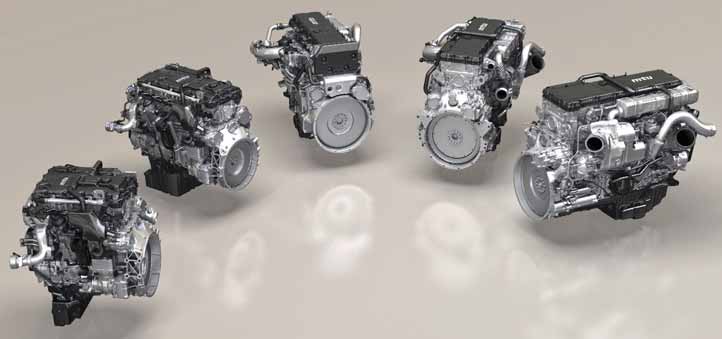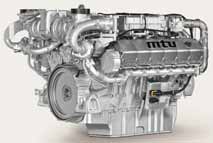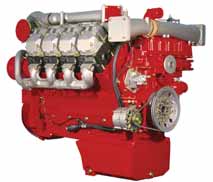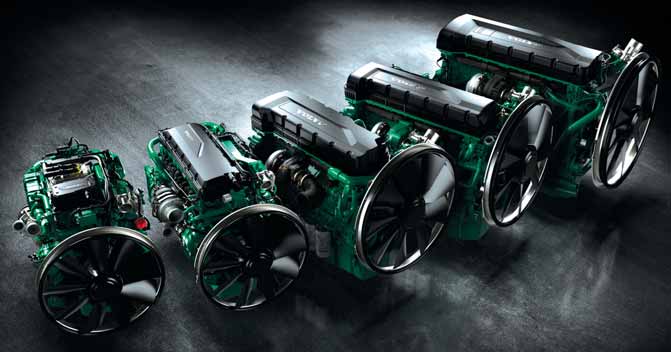With the latest deadline in the current
round of emissions-control tightening just
around the corner, the world’s dieselengine manufacturers have been working
to develop and verify the technologies
needed to meet the new requirements.
Not, of course, that this is a bad thing—the
hazards posed to health and safety (and
from time to time, visibility) by “dirty
diesels” are largely a thing of the past.
Modern technology produces engines that
are much cleaner and, most importantly in
an environment where fuel prices continue
to rise, much more fuel-efficient.
It is perhaps natural for industry-watchers to focus on the top end of the market
when looking at engine technology. After
all, big haulers, loaders and dozers need big
engines, and it is easy to be carried away by
the sheer size and power capabilities of a
piece of machinery that can output upward
of 3,000 kW. However, that view does a disservice to the much larger engine-market
segment that powers mid-range equipment
such as hydraulic excavators, mobile crushing and screening plant, drill rigs, graders,
wheel loaders, and trucks of a more modest
capacity. In volume terms, this generates
much more demand than the ultra-class
segment ever can, with equipment manufacturers able to follow two main routes for
powering their products: either developing
and building increasingly sophisticated
engines themselves or relying on specialist
engine suppliers to do so.
To give an idea of t he size and longevity of the third-party supply system, at
bauma, German engine manufacturer
Deutz took the opportunity to highlight its
remarkable relationship with Atlas Copco.
This year, the company will deliver the
500,000th Deutz engine to Atlas Copco in
a relationship that goes back to 1956.
Typical applicat ions include power unit s f or
compressors, gensets, construction equipment and mining equipment, with the various applications making use of virtually
the entire Deutz product range: both waterand air-cooled, the company said.
While bauma’s principal focus is on
construction, the bauma mining section of
the show continues to grow as manufacturers give greater recognition to mining’s
importance in the equipment marketplace.
Diesel-engine exhibitors included OEMs
such as Caterpillar, Liebherr and Volvo,
as well as specialist engine suppliers,
Cummins, Deutz and MTU. Each had plenty to say about their products, and their
suitability for meeting the new generation
of emission-control requirements.
The Road to Emissions
Control
At this stage, it is perhaps worth a reminder of exactly what has been involved
in the introduction of emissions-control
regulations for the off-highway market
since it first began in the 1990s. In the
United States, Tier 1 standards for new offroad diesel engines more than 37 kW
(50 hp) were phased in between 1996 and
2000, with Tiers 2 and 3 being introduced
between 2000 and 2008. In general, up to
now these standards have been met
through advanced engine design, with only
limited use of exhaust-gas after-treatment
by oxidation catalysts.
Tier 4, however, scheduled for introduction between 2008 and 2015, has much
more stringent requirements for emissions
of both nitrogen oxides (NOx
) and particulate matter (PM). Tier 4i (interim) preceded the Tier 4f (final) requirements, with
new engines producing less than 560 kW
required to meet Tier 4i by 2011 and Tier
4f by 2014. Manufacturers have had an
additional year to bring their larger engines
into compliance.
The exception to the U.S. Environmental Protection Agency’s requirements
is for diesel engines used in underground
equipment, for which the Mine Safety and
Health Administration has the responsibility for setting PM emission standards.
European Union (EU) requirements are
broadly similar in approach to those in the
U.S. market, with Stages I and II introduced between 1999 and 2004, then
Stages IIIA and IIIB becoming mandatory
for new engines during 2006-2008 and
2011–2012, respectively. The final EU
requirement, Stage IV, comes into play
next year for off-highway engines with an
output above 56 kW.
 Cat C7.1. (Photo courtesy of Caterpillar)
Cat C7.1. (Photo courtesy of Caterpillar)
Tognum gr oup specialist engine supplier
MTU told E&MJthat from January 2015,
off-highway engines with rated outputs
more than 560 kW will be subject to Tier 4f
emissions standards of 3.5 g/kWh for NOx
,
0.19 g/kWh for hydrocarbons, 3.5 g/kWh for
carbon monoxide and 0.04 g/kWh for PM.
However, Volvo Penta pointed out there
is a paradox in relation to achieving these
reductions. Focusing on reductions in NOx
results in increased PM, while lowering PM
levels will result in higher NOx
concentrations in the exhaust. Different engine manufacturers have followed different routes to
achieve the goal. Some (like Volvo Penta)
have opted exclusively for selective catalytic reduction and exhaust gas recirculation
as their main abatement mechanism, while
others have preferred to use diesel particulate filter technology as well, to ensure a
catch-all solution.
Caterpillar: Wider Range
of Rebuild Kits
Aside from powering its own products,
Caterpillar is a major supplier of industrial
engines to other equipment manufacturers. The company reported it is now offering a new generation of Tier 4f/Stage IV
engines from 25.2 to 895 kW (34–
1,200 hp) that give good fuel efficiency
and component life, with significantly
reduced emissions. Units on display at
bauma included the C1.5, C7.1 ACERT
and C18 ACERT engines, as well as the
C4.4 ACERT, C13 ACERT and C7.1 ACERT
power units.
Cat equips every Stage IV/Tier 4f engine
with a combination of electronic, fuel, air,
and after-treatment components based on
engine size, the type of application, and the
geographic location in which it will work.
The technologies offered include a diesel
oxidation catalyst (DOC), diesel particulate
filter (DPF) and selective catalytic reduction
(SCR), with a “No DPF” after-treatment
package available for some applications.
“As we designed our Stage IV/Tier 4
Final engines, we did so with the end in
mind in order to make integration as simple as possible for our OEM customers,”
said Mike Reinhart, Caterpillar industrial
marketing manager. “We’ve been able to
meet emission legislative standards while
delivering value to our customers. As a
result, we have the strongest, most complete product range available for customers
and manufacturers looking for a robust,
fuel efficient industrial engine solution.”
The larger engines on display were the
C13 and C18 ACERT units. The C13 is a
six-cylinder, 12.5-liter engine that delivers
287–388 kW (385–520 bhp) and is used in
a wide variety of applications such as crushing, drilling, materials handling and pumps.
Meanwhile, the C18 industrial engine is a
six-cylinder, 18.1-liter unit that is similarly
sized to its Stage IIIB/Tier 4i predecessor,
with twin DOCs fitted to the 563–597 kW
(755–800 bhp) ratings to comply with Tier
4f emission standards, Cat said.
 “X-ray” view of Liebherr’s Tier 4f-compliant engine
“X-ray” view of Liebherr’s Tier 4f-compliant engine
design. (Photo courtesy of Liebherr)
In April, Cat also announced an extension to the availability of its Precious
Metals engine-rebuild kits for some of its
machines. Available in four levels (Bronze,
Silver, Gold and Platinum), the kits are now
available for C9-powered equipment as
well as machines powered by 3406, 3306
and 3176 engines.
Bronze kits provide basic components
such as gaskets, seals, oil and fuel filters,
camshaft bearings, exhaust manifold
sleeves, etc. Silver kits include the Bronze
kit, plus new, unassembled pistons, piston
rings, retainers and cylinder liners, while
Gold kits include the Bronze kit and six Cat
Reman (remanufactured) pre-assembled
cylinder packs. Platinum kits include the
Bronze kit, plus the cylinder packs, a cylinder head, fuel injectors or fuel nozzles, a
water pump and an oil pump.
The types of equipment covered by
these kits include motor graders, excavators, mid-range tracked dozers, wheel dozers, wheel loaders and articulated trucks.
Liebherr: In-house Systems
Design
Since 1985, Liebherr has produced diesel
engines for use in its own machines as well
as to supply other equipment manufacturers. Its extensive stand at bauma showcased some of its current 11-model basic
range, which offer power outputs from 130
to 750 kW (174–1,005 hp). All of its fourand six-cylinder in-line engines, as well as
its V8 and V12 units, comply with the
Stage IV/Tier 4f emission regulations, the
company said.
Liebherr explained that in order to meet
the new criteria, it has intensively optimized the complete combustion process
with the aim of minimizing the level of particulates generated inside the engine. One
of the major factors in coordinating the various parameters involved has been the inhouse development of a common-rail fuel
injection system, together with a Liebherrdesigned electronic engine management
control unit.
 Scania’s Tier 4f engine design includes EGR.
Scania’s Tier 4f engine design includes EGR.
(Photo courtesy of Scania)
To keep t he syst em simple and opt imize
exhaust emission control in even the
toughest operating conditions, Liebherr
decided to concentrate on SCR technology.
This has economic benefits for the customer and also simplifies machinery
design, the company said. Since particulate emissions are already below the statutory limits, no measures are needed to
reduce them further. The SCR catalytic
converter, and its associated system components reduce NOx emissions by around
98%, Liebherr added.
Focusing on reducing particulates
formed inside the engine, Liebherr has increased the injection pressure and compression and reduced internal friction.
Other features of the new engines include
stable multiple injection, optimized combustion chamber geometry and efficient
forced aspiration. Meanwhile, the common-rail principle ensures efficient, accurate fuel injection. Soot particles inside the
combustion chambers are reduced to a
minimum, with lower fuel consumption.
Scania: Building on
Road-vehicle Technology
The Swedish engine and vehicle manufacturer, Scania, exhibited its 9-, 13- and
16-liter industrial engine families at
bauma, all of which are ready for 2014.
The three ranges offer power outputs of
202–294 kW, 257–405 kW and 404–
566 kW, respectively, with the 9-liter units
based on a five-cylinder in-line format, the
13-liter as an in-line six, and the 16-liter
as a compact V8. Each range features
Scania’s common-rail, extra-high-pressure
XPI fuel injection, charge cooling, exhaustgas recirculation (EGR) and SCR.
The difference from its previous engine
ranges, which complied with Tier 4i/Stage
IIIB, is the addition of EGR systems, the
company said, while pointing out that each
of the three engine ranges has the same
installation dimensions irrespective of the
emission level. Installation remains unaffected, it added, which significantly reduces the efforts required from OEMs that
are active on the global market.
 Cummins QSM12. (Photo courtesy of Cummins)
Cummins QSM12. (Photo courtesy of Cummins)
Scania pointed out that its industrial
engines have been developed in parallel
with engines for trucks and buses, thereby
complying with new emissions legislation
several years before it takes effect. Clean,
refined combustion technology means that
it manages the very stringent Tier 4f/Stage
IV regulations without the need for a particulate filter, the company having gained
many years of experience with EGR and
SCR from its trucks and buses.
Scania has also implemented a modular philosophy throughout its engine
ranges. This greatly facilitates servicing,
repairs and parts supply, since the engines
all share the same cylinder design, the
company said. They have cylinders with
replaceable liners and many common moving parts. “If you know one Scania, you
know them all, regardless of its configuration—in-line or V8,” the company said.
With EGR, a small amount of exhaust gas is returned to the engine intake,
diluting the intake air and reducing the oxygen concentration. This reduces the combustion temperature and the emissions of
both particulates and NOx
. The main function of the SCR system, meanwhile, is to
further reduce NOx
emissions. SCR is
based on the injection of a urea solution in
the exhaust system, with solution consumption running at around 5% of fuel
consumption for Tier 4f/Stage IV NOx
levels.
Cummins: New, Small
Mining Engine
At the smaller end of the mining engine
range, Cummins launched a new Tier 4fcompliant 12-liter engine, the QSM12.
However, some of its larger engines were
also featured prominently at bauma. The
two largest pieces of mining equipment on
show in Munich, Liebherr’s T264 truck
and R9400 mining shovel, are both powered by Cummins engines, while Cummins
exhibited its top-of-the-range 3,132-kW
(4,200-hp) QSK95 mining diesel on its
own stand.
The company said the QSM12 provides a compact configuration and offers
382 kW (512 hp) peak output. This
makes it suitable for powering equipment
such as wheel loaders and excavators with
a bucket capacity of up to 7 yd
3
, Cummins
added, as well as for LHDs with capacities
up to 20 tons.

MTU 1000-1500 family. (Photos courtesy of Tognum MTU)
With a six-cylinder in-line configuration, the QSM12 provides more than 30%
higher power density than the class average for engines with a similar power range,
while meeting the new emission limits
without the use of EGR, Cummins
claimed. Instead, higher-efficiency air
handling and advanced combustion
enable it to return to the simplicity of a
waste-gated turbocharger, then combining
a diesel particulate filter (DPF) with SCR
to achieve ultra-clean exhaust.
“For Tier 4 Final, the QSM12 sets a
new benchmark for heavy-duty engines
with its ability to outperform any comparable engine, while providing a smaller,
lighter and simpler engine package to
install,” said Hugh Foden, executive director for Cummins Off-Highway Business.
“The new QSM12 provides an ideal opportunity for equipment manufacturers to
downsize to a far more productive and
economic 12-liter engine, with all the
heavy-duty durability and performance
they need.”
The SCR system developed by
Cummins for Tier 4fl/Stage IV is a nextgeneration design with a copper zeolitebased catalyst capable of more than 95%
NOx
conversion. Diesel exhaust fluid (DEF)
dosing is minimized by the use of a highprecision injection spray pattern. When the
cost of the DEF is combined with the cost
of fuel consumed, the overall fluid operating cost of the Tier 4f QSM12 is lower than
that of the previous Tier 4i QSX11.9
engine, the company claimed. The company said that its experience of integrating
DPF and SCR technology as a single system is unmatched in the industry, with
almost 450,000 Cummins engines produced with this combined after-treatment.
Deutz: Opportunities to
Down-size
For old-timers in the mining industry, the
name Deutz was synonymous with the aircooled diesels used in LHDs and other
mobile equipment. Not any more—today
the company offers a wide range of both
air- and water-cooled units, and took the
opportunity provided by bauma to launch
its new generation of Tier 4f/Stage IV-compliant engines. These illustrate the current
trends in innovative engine construction,
Deutz said: adaptation to the latest emissions standards, downsizing and economy.
While several of the new engines on
show were best suited for lighter-weight
applications than would normally be found
in mining, the TCD 7.8 is the company’s
most powerful mid-class engine. Its maximum output of 250 kW (335 hp) and top
torque of 1,400 Nm advances this six-cylinder engine to a class that used to be dominated by 9-liter engines, Deutz said. The
engine has a long service life, long service
intervals and 3%–5% lower fuel consumption than its Tier 3 predecessor, it added.
The company’s V-engines also offer
robust design and low operating costs, with
a compact and light weight design. They
can fit into small spaces, so there is more
room for other components, it added. The
six-cylinder TCD 12.0 delivers a maximum
output of 390 kW (523 hp) while the
eight-cylinder TCD 16.0 is the company’s
largest unit with a 520 kW (697 hp) rating.
The TCD 12.0/16.0 engines conform to
Tier 4/St age I V wit h an SCR- only concept ,
using two SCR systems in series. Developed
from the DVERT SCR concept for these
engines at Tier 4i/Stage IIIB, this makes it
possible to dispense with EGR for V-engines.
 MTU 1600. (Photos courtesy of Tognum MTU)
MTU 1600. (Photos courtesy of Tognum MTU)
Deutz claims that its new generation of
engines can reduce fuel consumption by
3%-5%, depending on the application,
the load profile and the output, having
already gained 5%-10% better fuel economy in the transition to Tier 4i/Stage IIIB.
All of its new designs are compact and
produce low noise levels, with minimal
effort needed for installation.
MTU: Combustion
Optimization Focus
As noted in E&MJ’s bauma report (See
June, pp.98-109), MTU presented its fourand six-cylinder Series 1000 in-line
engines and six-cylinder Series 1100,
1300 and 1500 in-line engines at the
show. Designed for power outputs under
560 kW and equipped with SCR, these
engines comply with the EU Tier 4f/Stage
IV, with typical applications including haul
trucks, wheel loaders, mobile cranes, excavators and underground mining vehicles.
For countries with less stringent emissions
rules, MTU said it will continue to supply
its Series 900, 460 and 500 units.
From 2014, MTU’s 10- and 12-cylinder Series 1600 units will be extending
the engine range available up to 730 kW.
Launched in 2009, the Series 1600
engines are suitable for use in haul trucks,
wheel loaders, pump drives and drill rigs,
meeting Tier 4f requirements through the
use of high-pressure common-rail fuel
injection, two-stage turbocharging and
EGR with a cooling system. To keep fuel
consumption as low as possible, MTU has
focused on optimizing the combustion
processes.
 Deutz TCD 16 V-8. (Photo courtesy of Deutz)
Deutz TCD 16 V-8. (Photo courtesy of Deutz)
The Series 1600 now covers power outputs from 567 to 730 kW (760–979 bhp),
with a displacement volume of 1.75 liters
per cylinder. Unlike the smaller engine
models that are based on truck engines,
MTU developed Series 1600 as an
autonomous off-highway engine family.
MTU pointed out that in mobile
machinery applications, engines must not
only satisfy emissions legislation, but also
be specifically optimized to reduce their
space claim, weight and fuel consumption.
By building to a modular principle and
equipping them with a large number of
interchangeable options, MTU claims to
have designed engines that are specially
optimized for industrial applications.
Their few interface connections, such as
those for coolant, electronics and air-intake
piping, make Series 1600 installation quick
and inexpensive, the company added. The
charge-air coolers are directly mounted on
the engine, for example, with the straightforward installation features translating into
low overhaul and operating costs. MTU
pointed out that, as with all its engine families, most components on the V10 and V12
versions of the engine are identical, helping
to simplify spare-parts logistics and providing a wide range of options.
MTU’s primary approach to achieving
compliance with Tier 4f requirements has
been to reduce the pollutants generated by
combustion, by focusing on internal engine
emissions-reduction solutions. It has also
ensured that all EGR components are integrated into the engine in a compact way so
the size of the engine and the exhaust piping are not significantly affected. The twostage turbocharging system engine is
equipped with low- and high-level turbochargers at each cylinder bank, meaning
the engine can deliver power consistently at
all speeds, even at high altitude. This is an
ideal solution for off-highway vehicles,
which need high torque, even at low speeds.
All of the engine and turbocharger functions are controlled, regulated and monitored centrally by MTU’s advanced diesel
engine control unit (ADEC). By fine-tuning
high-pressure fuel injection to precisely
suit the given load status, this plays a major
role in efficient, low-emission engine operation. For easy integration by OEMs, ADEC
is equipped with an integrated SAE J1939
interface and several inputs and outputs,
ready for customization, MTU added.
 Volvo Penta’s mid-range diesel lineup will offer automatic start/stop capability. (Photo courtesy of Volvo Penta)
Volvo Penta’s mid-range diesel lineup will offer automatic start/stop capability. (Photo courtesy of Volvo Penta)
Volvo Penta: Underground
Mining Range
Swedish specialist engine manufacturer
Volvo Penta aims to release its full line of
Tier 4f - compliant indust r ial engines next
year. Its exhibit at bauma, meanwhile,
gave the industry a preview of these new
units, as well as the company’s new automatic start/stop technology (See E&MJ
June 2013).
Volvo Penta has focused specifically on
SCR technology to meet Tier 4f requirements, with the added advantage
that by doing so, it makes life easier for
all the equipment manufacturers already
employing this technology. David Hanngren, the company’s manager for industrial product planning, said, “With our new
Tier 4 Final engine r ange, we will meet our
customers’ primary objectives: no regeneration, limited installation challenges, continuous optimized fuel consumption and
low operating costs. With as few and as
simple changes as possible, we aim to
make our customers’ job as easy as possible,” he said. “This is probably the best
EGR system in the world.”
This “light” EGR system not only provides further emission reductions but also
helps to keep the SCR catalyst operating at
an optimal temperature, Volvo Penta
noted, while installation is greatly simplified by avoiding a costly DOC.
Volvo Penta will be offering a range of
five basic Tier 4f-compliant engine platforms. Sharing a common design concept
to ease OEM design and installation, they
will include 5-, 8-, 11-, 13- and 16-liter
units, covering a power output range from
105 to 515 kW (141–690 hp).
In the meantime, the company currently offers an 18-model range of engines
approved for underground mining applications: nine compliant with Tier 2 and nine
with Tier 4i. Power outputs range from 224
to 522 kW (300–700 hp), with all of the
Tier 4i- compliant unit s using SCR t echnology. Volvo Penta points out since they
require a ventilation rate of around
30 cfm/hp, these deliver the maximum ventilation rate available for a conventional
diesel engine—helping to cut ventilation
volumes and costs (See Ventilation p. 66).
As the company notes, while Tier 4f
represents a major step forward, the
process of lowering emissions in off-road
engines is far from over, with more stringent regulations in the pipeline. At the
moment, there is a clear divide between
those parts of the world where emissions
control is tightly regulated and those where
older standards still apply. As a result,
manufacturers have to be able to offer
engines that meet the requirements of
each individual market, regardless of
whether or not that is the most efficient
use of manufacturing resources.
If nothing else, what the phased introduction of increasingly tight emission-control requirements has done is drive the
world’s engine companies to greater ingenuity in terms of the technology being
applied. And, at the end of the day, better
fuel efficiency and improved working conditions can only be of benefit to mining
companies and the individual alike.








